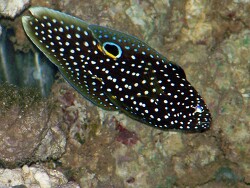Info
Calloplesiops altivelis (Steindachner, 1903)
The family of miraculous perches (Plesiopidae) belongs to the group of perch relatives and comprises eleven genera with over 50 species. They are mainly active at dusk and hide in caves and crevices during the day.
The miracle perch grows to a size of approx. 15-20 cm. Initially, these animals are very shy, which is due to the fact that in their natural habitat they are found at greater depths and as cave dwellers. The animals actually only imitate this behavior in the aquarium. Many people will notice that the perch immediately disappears into its cave when frightened and comes out tail first. Like everything else in the fish kingdom, there is a reason for this. With this action, it imitates the shape of a moray eel (mimikri = with the “eye” near its tail fin). In this way, a harmless animal becomes a great danger, at least for other fish, and they give it a wide berth.
However, the miracle perch becomes more trusting in the course of its existence in our aquariums, and although you won't see it all the time, you will see it much more often over time than at the beginning.
$slow eater
Shrimp/small fish in the aquarium?
Due to the natural hunting instinct, shrimp or even small fish are considered food and, if the size is suitable, are also hunted and eaten.
Even cleaner shrimp can fall victim to the hunter if the hunger is correspondingly large.
Additional information:
Adult males usually appear bulkier in the head and neck than females. The ventral fins of males are significantly longer.
Synonymised names
Barrosia barrosi Smith, 1952 · unaccepted
Callopresiops altivelis (Steindachner, 1903) · unaccepted (misspelling)
Plesiops altivelis Steindachner, 1903 · unaccepted
am 23.09.23#12
Hab meinen auch seit knapp einem Jahr. Scheu ist er gar nicht, immer da und zu sehen und wenn man im Aquarium hantiert, werde ich aus ca. 10cm Abstand zu meiner Hand genauestens beobachtet. Ich nenne ich liebevoll "Stalker" im Becken, weil er wirklich super neugierig ist und bei jeder Regung auch vor der Scheibe sofort angeschwommen kommt und auskundschaftet was da los ist. Frisst auch aus der Hand. Bei mir aber dasselbe gewesen... wollte einen zweiten einsetzen, dachte bei 750L und massiven Riffaufbau mit etlichen Rückzugs- und Versteckmöglichkeiten (Muräne mit im Becken und daher wurde bei Vergrößerung damals der Riffaufbau vermörtelt, massiv aufgebaut und ein Röhrensystem auch noch verlegt darunter) können die sich aus dem Weg gehen.... extra kleines Tier gewählt, aber ging nicht gut. Nachdem ich auch das kleinere Tier nicht erwischte, dieses zusehends aber schlechter aussah, wurde richtig vermöbelt von dem Großen mit zerfetzenden Flossen usw., fand ich dieses auch irgendwann tot.
Sehr schade wirklich. Hätte auch gerne ein Paar gepflegt, aber meiner ist wohl zu dominant bzw. betrachtet einfach die kompletten 750L als sein Revier. Andere Mitbewohner, ob Wirbellose oder Fisch ist er gegenüber friedlich. Frisst bei mir kein Trockenfutter.
am 18.01.11#18
Ich halte diesen schönen Fisch nun knapp ein Jahr und kann sagen das er jetzt so langsam seine Scheu verliert.Und das grade wenn es Futter gibt.Gefressen werden am liebsten Futtergarnelen und Frostfutter. Seid kurzem hat er aber auch das Granulat für sich entdeckt und findet dieses sehr lecker.
am 20.12.09#17
Hallo zusammen
Lebt sehr Versteckt in höhlen. Braucht sehr lange bis er sich ohne Furcht auch im Becken zeigt. Wenn er sich aber zeigt, dann ist er wunderschön!!!
Vorsicht wenn man Garnelen halten möchte.







 Alan Sutton, Tansania
Alan Sutton, Tansania















